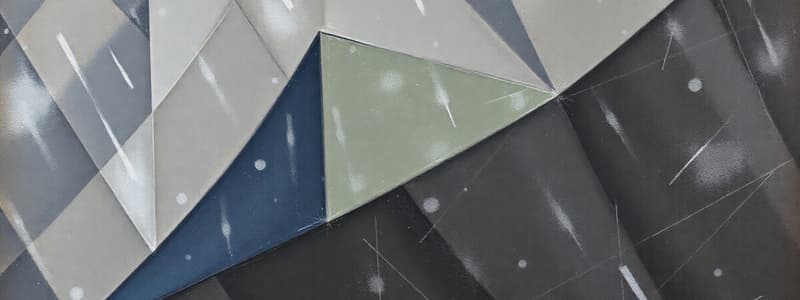Podcast
Questions and Answers
Which type of angle is greater than 90 degrees but less than 180 degrees?
Which type of angle is greater than 90 degrees but less than 180 degrees?
- Right Angle
- Straight Angle
- Obtuse Angle (correct)
- Acute Angle
What is the total sum of the interior angles of a quadrilateral?
What is the total sum of the interior angles of a quadrilateral?
- 90 degrees
- 540 degrees
- 360 degrees (correct)
- 180 degrees
In a circle, what is the relationship between the radius and the diameter?
In a circle, what is the relationship between the radius and the diameter?
- The radius is equal to the diameter.
- The radius cannot exceed the diameter.
- The diameter is half the radius.
- The diameter is double the radius. (correct)
What is the formula for calculating the area of a circle?
What is the formula for calculating the area of a circle?
Which of the following types of triangles has all sides of equal length?
Which of the following types of triangles has all sides of equal length?
What is the slope of a line passing through the points (2, 3) and (5, 11)?
What is the slope of a line passing through the points (2, 3) and (5, 11)?
What does the Pythagorean Theorem state for a right triangle?
What does the Pythagorean Theorem state for a right triangle?
Which transformation involves turning a shape around a fixed point?
Which transformation involves turning a shape around a fixed point?
Flashcards are hidden until you start studying
Study Notes
Geometry
-
Definition: The branch of mathematics dealing with shapes, sizes, relative positions of figures, and properties of space.
-
Basic Concepts:
- Point: A location in space, represented by coordinates.
- Line: A straight one-dimensional figure that extends infinitely in both directions.
- Plane: A flat, two-dimensional surface that extends infinitely in all directions.
-
Types of Angles:
- Acute Angle: Less than 90 degrees.
- Right Angle: Exactly 90 degrees.
- Obtuse Angle: Greater than 90 degrees but less than 180 degrees.
- Straight Angle: Exactly 180 degrees.
-
Triangles:
- Classification by Sides:
- Equilateral: All sides equal.
- Isosceles: Two sides equal.
- Scalene: All sides different.
- Classification by Angles:
- Acute: All angles acute.
- Right: One right angle.
- Obtuse: One obtuse angle.
- Classification by Sides:
-
Quadrilaterals:
- Types include squares, rectangles, parallelograms, trapezoids, and rhombuses.
- Sum of interior angles: 360 degrees.
-
Circles:
- Radius: Distance from the center to any point on the circle.
- Diameter: Double the radius; the longest chord of the circle.
- Circumference: The perimeter of the circle, calculated as C = πd or C = 2πr.
- Area: The space enclosed by the circle, calculated as A = πr².
-
Polygons:
- Defined by straight sides. Examples include triangles, quadrilaterals, pentagons, and hexagons.
- Sum of interior angles formula: (n - 2) × 180°, where n is the number of sides.
-
Coordinate Geometry:
- Uses a coordinate plane to define geometric shapes and positions.
- Key formulas:
- Distance between two points (x₁, y₁) and (x₂, y₂): √[(x₂ - x₁)² + (y₂ - y₁)²].
- Midpoint: ((x₁ + x₂)/2, (y₁ + y₂)/2).
- Slope: (y₂ - y₁)/(x₂ - x₁).
-
Transformations:
- Translation: Moving a shape without rotation or resizing.
- Rotation: Turning a shape around a fixed point.
- Reflection: Flipping a shape over a line (mirror image).
- Dilation: Resizing a shape while maintaining its proportions.
-
Theorems and Properties:
- Pythagorean Theorem: In a right triangle, a² + b² = c² (where c is the hypotenuse).
- Triangle Inequality Theorem: The sum of the lengths of any two sides of a triangle must be greater than the length of the third side.
- Congruence and Similarity: Congruent figures have the same shape and size; similar figures have the same shape but different sizes.
-
Applications:
- Used in architecture, engineering, astronomy, and various fields of science.
- Important for solving real-world problems involving shapes and space.
Geometry Basics
- Geometry: The study of shapes, sizes, and positions of figures in space
- Basic Shapes: Include points, lines, planes, and angles.
- Angles: Classified as acute, right, obtuse, or straight based on their measure
- Triangles: Can be classified by sides (equilateral, isosceles, scalene) or by angles (acute, right, obtuse)
- Quadrilaterals: Include squares, rectangles, parallelograms, trapezoids, and rhombuses. The sum of their interior angles is always 360 degrees.
Circles and Polygons
- Circles: Defined by their radius, diameter, circumference, and area.
- Radius: Distance from the center to any point on the circle
- Diameter: The longest chord of the circle, twice the radius
- Circumference: The perimeter of the circle, calculated as C = πd or C = 2πr
- Area: The space enclosed by the circle, calculated as A = πr²
- Polygons: Closed figures with straight sides.
- Sum of Interior Angles of a Polygon: Calculated as (n - 2) × 180°, where n is the number of sides.
Coordinate Geometry and Transformations
- Coordinate Geometry: Uses a coordinate plane to define geometric shapes and positions.
- Key Formulas:
- Distance between two points: √[(x₂ - x₁)² + (y₂ - y₁)²]
- Midpoint of a line segment: ((x₁ + x₂)/2, (y₁ + y₂)/2)
- Slope of a line: (y₂ - y₁)/(x₂ - x₁)
- Transformations: Include translation, rotation, reflection, and dilation.
Theorems and Properties
- Pythagorean Theorem: In a right triangle, the square of the hypotenuse (c) is equal to the sum of the squares of the other two sides (a and b): a² + b² = c²
- Triangle Inequality Theorem: The sum of the lengths of any two sides of a triangle must be greater than the length of the third side.
- Congruence and Similarity: Congruent figures have the same shape and size, while similar figures have the same shape but different sizes.
Applications of Geometry
- Architecture and Engineering: Used in construction and design.
- Astronomy: Used to understand celestial objects and their positions.
- Science: Used in various fields to solve problems involving shapes and space.
Studying That Suits You
Use AI to generate personalized quizzes and flashcards to suit your learning preferences.




